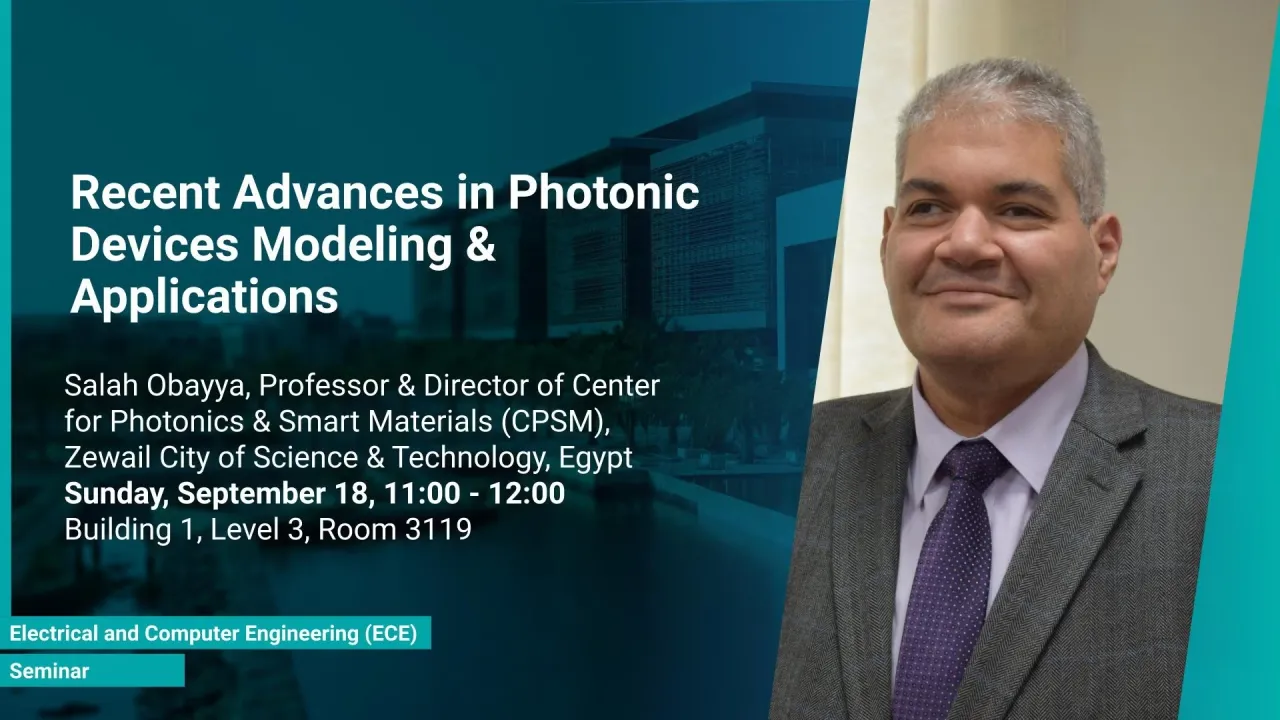
Recent Advances in Photonic Devices Modeling & Applications
- Salah Obayya, Professor and Director of Center for Photonics and Smart Materials (CPSM) Zewail City of Science and Technology
B1 L3 R3119
Dr. Obayya will present the most recent research results achieved at the Center for Photonics and Smart Materials (CPSM), Zewail city, in connection with analysis, design and optimization of wide range of photonic devices with applications in optical communications, plasmonics, metamaterials, energy harvesters, optical biosensors, and many others.
Overview
Abstract
The 20th century was known for the ‘Electronics’ revaluation, whereas the 21st century is truly coined as the ‘Photon’ century where it is really difficult to miss photonics technology in all aspects of our daily life. On the other hand, the last decade also witnessed dramatic progress and interest in the micro- and nano-fabrication techniques of complex photonic devices. In almost all cases, an accurate quantitative theoretical modeling of these devices has to be based on advanced computational techniques that solve the corresponding, numerically very large linear, nonlinear, or coupled partial differential equations. In this talk, Dr. Obayya will present the most recent research results achieved at the Center for Photonics and Smart Materials (CPSM), Zewail city, in connection with the analysis, design, and optimization of a wide range of photonic devices with applications in optical communications, plasmonics, metamaterials, energy harvesters, optical biosensors, and many others.
Brief Biography
Salah S A Obayya joined Zewail City of Science and Technology (ZC) in 2012 where he is now Chair Professor and Founding Director of the Center for Photonics and Smart Materials (CPSM). He occupied the positions of the Vice Chairman of ZC and Director-General of Research Institutes at the same institution. Prior to Zewail City, he took up several academic posts at Brunel University UK (tenured Associate Professor, 2002), University of Leeds, UK (tenured Professor, 2006), and the University of South Wales, UK (tenured Chair Professor, 2008) where he was the Founding Director of Photonics and Broadband Communications (PBC) Research Center and also he was the Director of Postgraduate Programs at the same institution. In May 2006, he has been naturalized as a “British” citizen.
He has established an outstanding international reputation in the area of green nanophotonics with a focus on the intelligent computational modeling of modern nano-photonic devices enabling technologies needed to realize a low-carbon green society. He has published 285 journal publications, mostly in OSA, IEEE, and IET/IEE, and authored 3 books (Computational Photonics, Wiley 2010 and Computational Liquid Crystal Photonics, Wiley 2016, Computational of Photonic sensors, 2018) both are adopted references for Graduate Programs in Photonics at international Universities such as MIT, Purdue University, Indian Institute of Technology, National University of Singapore, Mansoura University and Zewail City, and 269 conference papers in an international conference in photonics, many of these are invited talks, and keynote lectures, attracted external funding, from both industry and Research Councils, in the region of $ 4.4M, and supervised to successful completion 40 Ph.D. students, over 80 MSc/MRes/MPhil students and 15 postdoctoral research fellows. He led the team that developed one of the world’s best comprehensive numerical packages for the analysis, design, and optimization of nano-photonic devices, and subsystems, where a number of “world-first” numerical approaches have been developed. His five key papers introducing his novel numerical package; have been cited more than 400 times. His publications also have been cited more than 4869 times, with an h-index of 38 and i10-index of 139. His numerical package has been widely adopted by both academic and industrial Photonics communities to analyze, design, and optimize the performance of a wide range of nano-photonic devices employed for applications in solar cells, optical telecoms, sensing, optical imaging and encryption, and other applications.
He has served the International Photonics Society through active contribution to the organization and technical committees of a number of international conferences, and editorship of many prestigious photonic Journals. Over the past few years, I have received over 30 International and Regional recognitions such as Fellow of IEEE, OSA, SPIE, APS, ACES, IET, IOP, and many others.